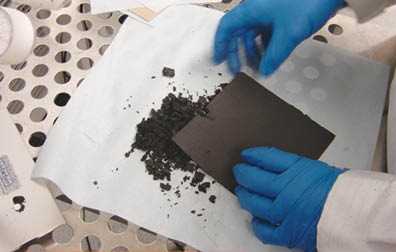Approaches to Safe Nanotechnology: Document Provides Guidance to Protect Nanotechnology Workers
September 2011
DHHS (NIOSH) Publication Number 2011-206

NIOSH document provides guidelines for use of Personal Protective Equipment while working with nanomaterials. Photo by Mark Methner.
A Story of Impact:
Nanotechnology is defined as the ability to manipulate and control matter at a size of 1 to 100 nanometers. For perspective, there are one billion nanometers in 1 meter; a single sheet of paper is 100,000 nanometers thick.1 Nanotechnology is a rapidly developing field with the potential to revolutionize countless areas of technology and industry. Current applications are wide-ranging: nanotechnology is being used to make computers faster and smaller, to produce more efficient and less expensive batteries and solar panels, to enhance early diagnosis of atherosclerosis and Alzheimer’s Disease, and to make hundreds of consumer products more lightweight, durable, and resilient.2
Research has shown that materials on this small scale begin to exhibit physical, chemical, and biological behaviors that are quite unique. These unique properties raise concerns about the health impacts of nanotechnology, particularly among workers employed in nanotechnology-related industries.3
The National Institute for Occupational Safety and Health (NIOSH) established the Nanotechnology Research Center to better understand the potential risks from occupational exposure to nanomaterials, and is conducting research on a multitude of nanotechnology-related topics in an effort to protect the nanotechnology workforce from work-related injury and illness.
In 2009 NIOSH published Approaches to Safe Nanotechnology: Managing the Health and Safety Concerns Associated with Engineered Nanomaterials, updating a 2005 report. This document, which incorporates the latest research on nanoparticle toxicity and assessment of workplace exposure, presents guidelines for the use of engineering controls and personal protective equipment to minimize worker exposures. A key component of the document is the standardization of the method used to evaluate processes and measure worker exposures, which provides the data necessary to design an effective exposure elimination strategy. NIOSH collaborated with multiple partners within the nanotechnology industry, the U.S. federal government, and internationally to create a practical risk management approach for safely working with engineered nanomaterials while protecting worker health.3
Impact
By 2010 this document had been widely cited and reviewed around the world. Japan, Australia, and the United Kingdom have all referenced this document when creating nanotechnology guidance, and the International Organization for Standardization (ISO) Technical Committee on Nanomaterials used the document as the basis for a major technical standard on occupational health and safety practices in the field of nanotechnology.4 It has been identified by the Director of the U.S. National Nanotechnology Coordination Office as a key contribution to national and international activities addressing health and safety concerns of nanotechnology.5 This NIOSH document has led to the adoption of responsible risk management practices by U.S. nanotechnology businesses6 by providing background, rationale, and guidance for adopting a precautionary approach in the manufacture and use of engineered nanomaterials. The risk management framework presented in the document allows for responsible development in this evolving field so society can benefit from the many potential applications while protecting the health of the workers involved.
References
1 U.S. National Nanotechnology Initiative. Nano.gov: size of the nanoscale [http://www.nano.gov/nanotech-101/what/nano-size]. Date accessed: May 2011.
2 U.S. National Nanotechnology Initiative. Nano.gov: Nanotechnology and you, benefits and applications. [http://www.nano.gov/you/nanotechnology-benefits]. Date accessed: May 2011.
3 NIOSH [2010]. Nanotechnology Overview[ http://www.cdc.gov/niosh/topics/nanotech/]. Date accessed: May 2011.
4 International Organization for Standardization [2008]. ISO Standard 12885:2008 Nanotechnologies-Health and safety practices in occupational settings relevant to nanotechnologies.
5 Teague C, Director, National Nanotechnology Coordination Office [2008]. Presentation at the TAPPI Conference on nanotechnology in the forest products industry in June 2008.
6 Dahm MM, Yencken MS, Schubauer-Berigan, MK [in press]. Exposure control strategies in the carbonaceous nanomaterial industry. Journal of Occupational and Environmental 53(6S).
7 Roco M, Mirkin C, Hersam M [2010]. Nanotechnology research directions for societal needs in 2020: retrospective and outlook. Boston and Berlin: Springer. [http://wtec.org/nano2/].
8 8. NIOSH [2009]. Approaches to safe nanotechnology: managing the health and safety concerns associated with engineered nanomaterials. Cincinnati, OH: U.S. Department of Health and Human Services, Centers for Disease Control and Prevention, National Institute for Occupational Safety and Health, DHHS (NIOSH) Publication Number 2009-125. [http://www.cdc.gov/niosh/docs/2009-125/].
- Page last reviewed: June 6, 2014
- Page last updated: June 6, 2014
- Content source:
- National Institute for Occupational Safety and Health Education and Information Division


 ShareCompartir
ShareCompartir